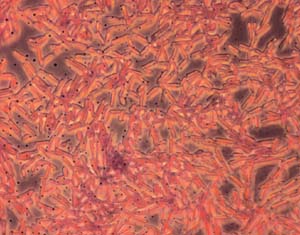| 2004 |

|
YEAR BOOK |
University College Dublin
|
Using genomics to combat an emerging pathogen
|

When the yeast is growing on the plastic surfaces of these devices it forms a structure called a 'biofilm'. Biofilms form when the yeast adhere to surfaces, rather than living freely in culture. They are very resistant to treatment with antifungal drugs, and often the infected device has to be removed.
We wish to understand how Candida parapsilosis grows on catheter surfaces, and how it contributes to disease. We are the first to study the genome in this yeast, and to investigate how regulation of specific genes contributes to growth on medical devices. The C. parapsilosis genome is estimated to consist of about 13 million bases and 6,800 genes. In the past year, we have partially sequenced the genome, and we have identified more than 10 million bases and 3,900 genes.
We are now using this information to design gene-specific oligonucleotides, and we will manufacture glass slide microarrays representing as many genes as possible. These will be used to determine the transcriptional profile (the pattern of genes expressed) of yeasts growing in biofilms.
We have already used a similar approach to identify a regulatory gene that is important in biofilm growth in a related yeast, Candida albicans. Our goal is to identify the genes that are important for adhering to plastic surfaces, and those that allow the yeasts to grow as a biofilm. The long term goal is to identify targets that will allow the development of new antifungal drugs.
Contact: Dr Geraldine Butler, Department of Biochemistry,
Conway Institute of Biomolecular and Biomedical Research, UCD, Belfield, Dublin 4;
E-mail: [email protected] ; Web: http://www.ucd.ie/biochem/gb/Lab/